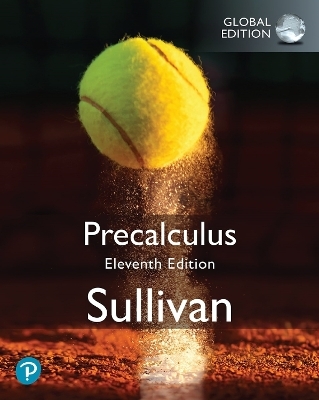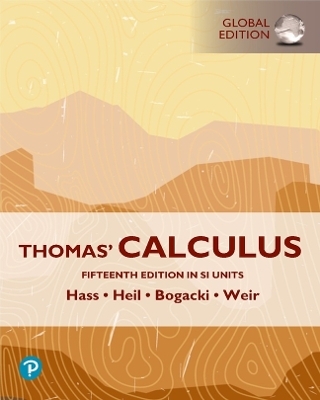
MyLab Math with Pearson eText for Precalculus, Global Edition
Pearson Education Limited (Hersteller)
978-1-292-44454-3 (ISBN)
Prepare. Practice. Review. Michael Sullivan's time-tested approach helps students focus on the fundamental skills they need for the course: preparing for class, practicing with homework, and reviewing the concepts. The 11th Edition continues to evolve to meet the needs of today's students.
This series prepares and supports students with access to help, where and when they require it. The hallmark Sullivan cycle of continuous preparation and retention—along with the high-quality exercises that Sullivan texts are known for—gives students the reinforcement they need.
Also available with MyLab Math
By combining trusted author content with digital tools and a flexible platform, MyLab Math personalizes the learning experience and improves results for each student.
Mike Sullivan recently retired as Professor of Mathematics at Chicago State University, having taught there for more than 30 years. He received his PhD in mathematics from Illinois Institute of Technology. He is a native of Chicago’s South Side and currently resides in Oak Lawn, Illinois. Mike has four children; the two oldest have degrees in mathematics and assisted in proofing, checking examples and exercises, and writing solutions manuals for this project. His son, Mike Sullivan, III, co-authored the Sullivan Graphing with Data Analysis series as well as this series. Mike has authored or co-authored more than ten books. He owns a travel agency, and splits his time between a condo in Naples, Florida and a home in Oak Lawn, where Mike enjoys gardening. Mike Sullivan, III is a professor of mathematics at Joliet Junior College. He holds graduate degrees from DePaul University in both mathematics and economics. Mike is an author or co-author on more than 20 books, including a statistics book and a developmental mathematics series. Mike is the father of three children and an avid golfer who tries to spend as much of his limited free time as possible on the golf course.
1. Graphs
1.1 The Distance and Midpoint Formulas
1.2 Graphs of Equations in Two Variables; Intercepts; Symmetry
1.3 Lines
1.4 Circles Chapter 1 Review, Test, and Projects
2. Functions and Their Graphs
2.1 Functions
2.2 The Graph of a Function
2.3 Properties of Functions
2.4 Library of Functions; Piecewise-defined Functions
2.5 Graphing Techniques: Transformations
2.6 Mathematical Models: Building Functions Chapter 2 Review, Test, and Projects
3. Linear and Quadratic Functions
3.1 Properties of Linear Functions and Linear Models
3.2 Building Linear Models from Data
3.3 Quadratic Functions and Their Properties
3.4 Build Quadratic Models from Verbal Descriptions and from Data
3.5 Inequalities Involving Quadratic Functions Chapter 3 Review, Test, and Projects
4. Polynomial and Rational Functions
4.1 Polynomial Functions
4.2 Graphing Polynomial Functions; Models
4.3 Properties of Rational Functions
4.4 The Graph of a Rational Function
4.5 Polynomial and Rational Inequalities
4.6 The Real Zeros of a Polynomial Function Chapter 4 Review, Test, and Projects
5. Exponential and Logarithmic Functions
5.1 Composite Functions
5.2 One-to-One Functions; Inverse Functions
5.3 Exponential Functions
5.4 Logarithmic Functions
5.5 Properties of Logarithms
5.6 Logarithmic and Exponential Equations
5.7 Financial Models
5.8 Exponential Growth and Decay Models; Newton’s Law; Logistic Growth and Decay Models
5.9 Building Exponential, Logarithmic, and Logistic Models from Data Chapter 5 Review, Test, and Projects
6. Trigonometric Functions
6.1 Angles, Arc, Length, and Circular Motion
6.2 Trigonometric Functions: Unit Circle Approach
6.3 Properties of the Trigonometric Functions
6.4 Graphs of the Sine and Cosine Functions
6.5 Graphs of the Tangent, Cotangent, Cosecant, and Secant Functions
6.6 Phase Shift; Sinusoidal Curve Fitting Chapter 6 Review, Test, and Projects
7. Analytic Trigonometry
7.1 The Inverse Sine, Cosine, and Tangent Functions
7.2 The Inverse Trigonometric Functions (Continued)
7.3 Trigonometric Equations
7.4 Trigonometric Identities
7.5 Sum and Difference Formulas
7.6 Double-angle and Half-angle Formulas
7.7 Product-to-Sum and Sum-to-Product Formulas Chapter 7 Review, Test, and Projects
8. Applications of Trigonometric Functions
8.1 Right Triangle Trigonometry; Applications
8.2 The Law of Sines
8.3 The Law of Cosines
8.4 Area of a Triangle
8.5 Simple Harmonic Motion; Damped Motion; Combining Waves Chapter 8 Review, Test, and Projects
9. Polar Coordinates; Vectors
9.1 Polar Coordinates
9.2 Polar Equations and Graphs
9.3 The Complex Plane; De Moivre’s Theorem
9.4 Vectors
9.5 The Dot Product
9.6 Vectors in Space
9.7 The Cross Product
Chapter 9 Review, Test, and Projects
10. Analytic Geometry
10.1 Conics
10.2 The Parabola
10.3 The Ellipse
10.4 The Hyperbola
10.5 Rotation of Axes; General Form of a Conic
10.6 Polar Equations of Conics
10.7 Plane Curves and Parametric Equations Chapter 10 Review, Test, and Projects
11. Systems of Equations and Inequalities
11.1 Systems of Linear Equations: Substitution and Elimination
11.2 Systems of Linear Equations: Matrices
11.3 Systems of Linear Equations: Determinants
11.4 Matrix Algebra
11.5 Partial Fraction Decomposition
11.6 Systems of Nonlinear Equations
11.7 Systems of Inequalities
11.8 Linear Programming Chapter 11 Review, Test, and Projects
12. Sequences; Induction; the Binomial Theorem
12.1 Sequences
12.2 Arithmetic Sequences
12.3 Geometric Sequences; Geometric Series
12.4 Mathematical Induction
12.5 The Binomial Theorem Chapter 12 Review, Test, and Projects
13. Counting and Probability
13.1 Counting
13.2 Permutations and Combinations
13.3 Probability Chapter 13 Review, Test, and Projects
14. A Preview of Calculus: The Limit, Derivative, and Integral of a Function
14.1 Finding Limits Using Tables and Graphs
14.2 Algebra Techniques for Finding Limits
14.3 One-sided Limits; Continuous Functions
14.4 The Tangent Problem; The Derivative
14.5 The Area Problem; The Integral Chapter 14 Review, Test, and Projects
Appendix A: Review
A.1 Algebra Essentials
A.2 Geometry Essentials
A.3 Polynomials
A.4 Synthetic Division
A.5 Rational Expressions
A.6 Solving Equations
A.7 Complex Numbers; Quadratic Equations in the Complex Number System
A.8 Problem Solving: Interest, Mixture, Uniform Motion, Constant Rate Job Applications
A.9 Interval Notation; Solving Inequalities
A.10 nth Roots; Rational Exponents
Appendix B: Graphing Utilities
B.1 The Viewing Rectangle
B.2 Using a Graphing Utility to Graph Equations
B.3 Using a Graphing Utility to Locate Intercepts and Check for Symmetry
B.4 Using a Graphing Utility to Solve Equations
B.5 Square Screens
B.6 Using a Graphing Utility to Graph Inequalities
B.7 Using a Graphing Utility to Solve Systems of Linear Equations
B.8 Using a Graphing Utility to Graph a Polar Equation
B.9 Using a Graphing Utility to Graph Parametric
Equations
Answers
Credits
Index
| Erscheint lt. Verlag | 26.4.2023 |
|---|---|
| Verlagsort | Harlow |
| Sprache | englisch |
| Themenwelt | Mathematik / Informatik ► Mathematik ► Analysis |
| ISBN-10 | 1-292-44454-1 / 1292444541 |
| ISBN-13 | 978-1-292-44454-3 / 9781292444543 |
| Zustand | Neuware |
| Haben Sie eine Frage zum Produkt? |
aus dem Bereich

